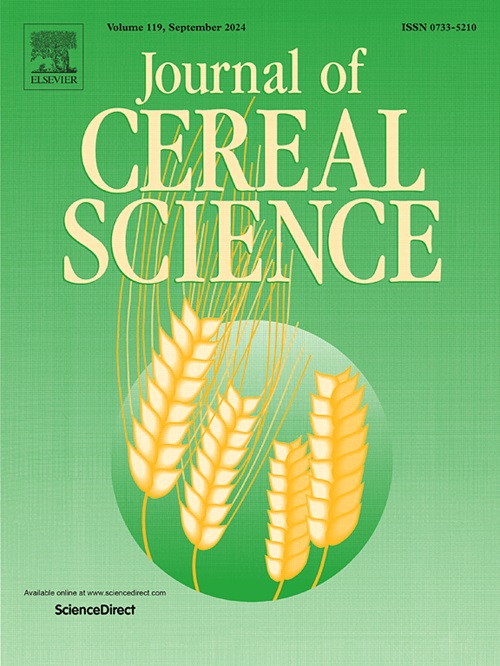Effect of wheat grain germination time on physicochemical and texture properties, starch digestion, and protein hydrolysis rate in bread making
IF 3.9
2区 农林科学
Q2 FOOD SCIENCE & TECHNOLOGY
引用次数: 0
Abstract
Currently, consumers exhibit heightened interest in the nutritional quality of baked foods. The germination process of wheat affects the chemical composition of flours, the morphological characteristics of starches, and the digestibility properties of proteins and starches. Wheat grains were germinated (GG) for periods of 12 and 48 h. Mixtures were prepared using the germinated flour with different proportion of ungerminated (UG)flour for bread production. The germination time of the wheat grains resulted in alterations in lipid, protein, and carbohydrate content of the flours. Germination of wheat for 12-h (GG-12 h) caused a reduction in the values of maximum extension resistance (0.28 N–0.11 N) and maximum extensibility (10.19 mm–4.15 mm) in the dough, when compared to the UG wheat dough. Breads made with germinated flours exhibited a higher specific volume and a lower hardness compared to breads made with ungerminated flour. This is attributed to the enhanced gas retention capacity during fermentation and the interaction of gluten proteins modified by germination. Rapid digestibility of starch (RDS) value in the GG-48 h bread, was lower, 38.18%, compared to UG bread, 44.51%. Conversely, the slow digestibility of starch (SDS) value in the GG-48 h bread was higher, 13.15%, compared to UG bread, 3.32%. Also, the in vitro protein digestibility value in the GG-48 h was higher, 80.32% compared to UG bread, 76.61%, which indicated that the germination process favors the quality of the bread.

目前,消费者对烘焙食品的营养质量表现出更大的兴趣。小麦的发芽过程会影响面粉的化学成分、淀粉的形态特征以及蛋白质和淀粉的消化特性。将发芽的面粉与不同比例的未发芽(UG)面粉混合,用于制作面包。小麦的发芽时间会导致面粉中脂质、蛋白质和碳水化合物含量的变化。与未发芽小麦面团相比,发芽 12 小时(GG-12 小时)的小麦导致面团的最大延伸阻力值(0.28 N-0.11 N)和最大延伸性(10.19 mm-4.15 mm)降低。与使用未发芽面粉制作的面包相比,使用发芽面粉制作的面包比容更大,硬度更低。这归因于发酵过程中气体保留能力的增强,以及发芽改变的面筋蛋白的相互作用。与 UG 面包(44.51%)相比,GG-48 小时面包的淀粉快速消化率(RDS)值较低,为 38.18%。相反,与 UG 面包的 3.32% 相比,GG-48 h 面包的淀粉慢消化率(SDS)值较高,为 13.15%。此外,GG-48 h 面包的体外蛋白质消化率值为 80.32%,高于 UG 面包的 76.61%,这表明发芽过程有利于面包的质量。
本文章由计算机程序翻译,如有差异,请以英文原文为准。
求助全文
约1分钟内获得全文
求助全文
来源期刊

Journal of Cereal Science
工程技术-食品科技
CiteScore
7.80
自引率
2.60%
发文量
163
审稿时长
38 days
期刊介绍:
The Journal of Cereal Science was established in 1983 to provide an International forum for the publication of original research papers of high standing covering all aspects of cereal science related to the functional and nutritional quality of cereal grains (true cereals - members of the Poaceae family and starchy pseudocereals - members of the Amaranthaceae, Chenopodiaceae and Polygonaceae families) and their products, in relation to the cereals used. The journal also publishes concise and critical review articles appraising the status and future directions of specific areas of cereal science and short communications that present news of important advances in research. The journal aims at topicality and at providing comprehensive coverage of progress in the field.
 求助内容:
求助内容: 应助结果提醒方式:
应助结果提醒方式:


